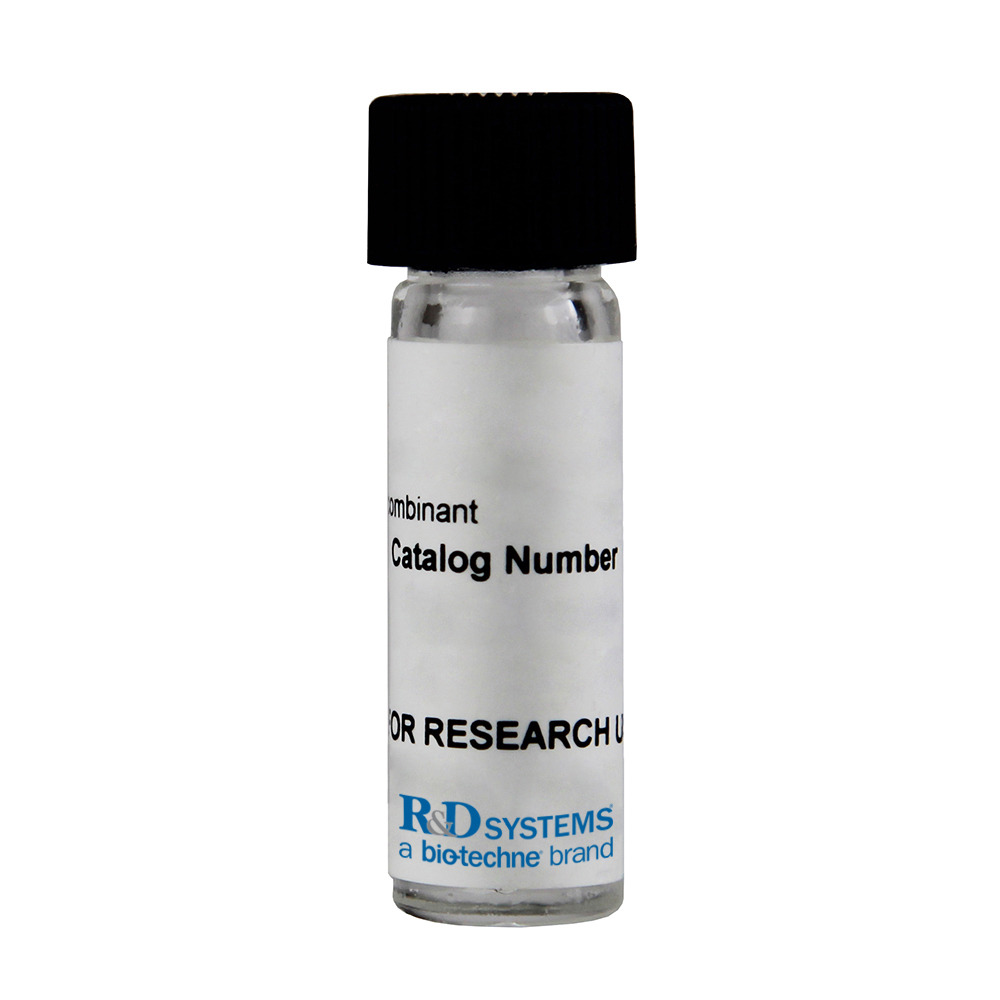

 下载产品说明书
下载产品说明书 下载SDS
下载SDS 用小程序,查商品更便捷
用小程序,查商品更便捷



 收藏
收藏
 对比
对比 咨询
咨询Carrier Free
CF stands for Carrier Free (CF). We typically add Bovine Serum Albumin (BSA) as a carrier protein to our recombinant proteins. Adding a carrier protein enhances protein stability, increases shelf-life, and allows the recombinant protein to be stored at a more dilute concentration. The carrier free version does not contain BSA.
In general, we advise purchasing the recombinant protein with BSA for use in cell or tissue culture, or as an ELISA standard. In contrast, the carrier free protein is recommended for applications, in which the presence of BSA could interfere.
3174-MP
| Formulation | Lyophilized from a 0.2 μm filtered solution in Tris and NaCl. |
| Reconstitution | Reconstitute at 0.5-1 mg/mL in sterile, deionized water. |
| Shipping | The product is shipped with polar packs. Upon receipt, store it immediately at the temperature recommended below. |
| Stability & Storage: | Use a manual defrost freezer and avoid repeated freeze-thaw cycles.
|
Recombinant Human Myeloperoxidase Protein, CF Summary
Product Specifications
Ala49-Ser745, with a C-terminal 10-His tag
Analysis

Background: Myeloperoxidase/MPO
Myeloperoxidase (MPO) is a heme-containing enzyme belonging to the XPO subfamily of peroxidases. It is an abundant neutrophil and monocyte glycoprotein that catalyzes the hydrogen peroxide-dependent conversion of chloride, bromide, and iodide to multiple reactive species (1). Post-translational processing of MPO involves the insertion of a heme moiety and the proteolytic removal of both a propeptide and a 6 aa internal peptide (2). This results in a disulfide-linked dimer composed of a 60 kDa heavy and 12 kDa light chain that associate into a 150 kDa enzymatically active tetramer. The tetramer contains two heme groups and one disulfide bond between the heavy chains (2). Alternate splicing generates two additional isoforms of MPO, one with a 32 aa insertion in the light chain, and another with a deletion of the signal sequence and part of the propeptide (3). Human and mouse MPO share 87% aa sequence identity. MPO activity results in protein nitrosylation and the formation of 3-chlorotyrosine and dityrosine crosslinks (4‑6). Modification of ApoB100, as well as the lipid and cholesterol components of LDL and HDL, promotes the development of atherosclerosis (5, 7‑9). MPO is also associated with a variety of other diseases (1), and inhibits vasodilation in inflammation by depleting the levels of NO (10). Serum albumin functions as a carrier protein during MPO movement to the basolateral side of epithelial cells (11). MPO is stored in neutrophil azurophilic granules. Upon cellular activation, it is deposited into pathogen-containing phagosomes (2). While mice lacking MPO are impaired in clearing select microbial infections, MPO deficiency in humans does not necessarily result in heightened susceptibility to infections (12, 13).
- Klebanoff, S.J. (2005) J. Leukoc. Biol. 77:598.
- Hansson, M. et al. (2006) Arch. Biochem. Biophys. 445:214.
- Hashinaka, K. et al. (1988) Biochemistry 27:5906.
- van Dalen, C.J. et al. (2000) J. Biol. Chem. 275:11638.
- Hazen, S.L. and J.W. Heinecke (1997) J. Clin. Invest. 99:2075.
- Heinecke, J.W. et al. (1993) J. Clin. Invest. 91:2866.
- Podrez, E.A. et al. (1999) J. Clin. Invest. 103:1547.
- Bergt, C. et al. (2004) Proc. Natl. Acad. Sci. 101:13032.
- Hazen, S.L. et al. (1996) J. Biol. Chem. 271:23080.
- Eiserich, J.P. et al. (2002) Science 296:2391.
- Tiruppathi, C. et al. (2004) Proc. Natl. Acad. Sci. 101:7699.
- Aratani Y. et al. (2000) J. Infect. Dis. 182:1276.
- Kutter, D. (1998) J. Mol. Med. 76:669.









 危险品化学品经营许可证(不带存储) 许可证编号:沪(杨)应急管危经许[2022]202944(QY)
危险品化学品经营许可证(不带存储) 许可证编号:沪(杨)应急管危经许[2022]202944(QY)  营业执照(三证合一)
营业执照(三证合一)